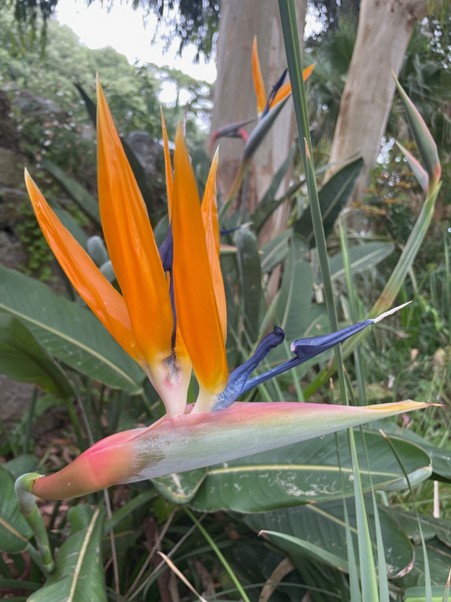
July Plant Fix
In the Further East area of VBG the spring planted specimens are establishing despite the very dry conditions. The Ventnor soil is unforgiving in the first year of planting, so we support with water during this period. Amongst the rarer plants are some old favourites, including the blue Hydrangea “Blue Wave” above. This group of Hydrangeas will have blue flowers where the soil is acidic enough, or pink in alkaline conditions.
At the other end of the esoteric scale is Hydrangea macrophylla subsp. stylosa (below). Undeservedly very rarely encountered, this was found at 2400m in W. Yunnan. A deciduous shrub to 1.5m in height with relatively slim foliage, superbly tinted charcoal-purple in summer and covered in a mass of splendid, strikingly bi-coloured lacecaps in July; the central fertile flowers are surrounded by frilly-edged, pure white ray florets. Pink and white in the alkaline soil found farther along the Dr Henry Behrend Walk.

Dichroa aff. febrifuga (below) is related to Hydrangea and can be found at the Japanese Bridge end of the Asian Terraces. It is considered tender at many gardens, and has proven to be very slow growing at Ventnor. Collected originally in N. Vietnam on Tay Con Linh, this plant also has flowers which are very blue on acid soils, and pink on alkaline. Diffuse heads of thick petalled flowers produced in late summer/autumn, followed by intense-blue berries.

The Hydrangea paniculata “Early Sensation” (below) arrived with us from the late, lamented Brockhill Nursery of Graham and Heather Meadowcroft. Their selection of this cultivar is exceptional, and its another colour changing Hydrangea, the white turns to pink with age.

Unrelated, but bearing a resemblance, is Cornus kousa “Miss Satomi” (below). This is a Japanese selection of a well known shrub, it has superior reddy pink bracts. It has taken a long time to establish , arriving in 2016. The north facing terraces are dry in spring and summer.

Pinellia tripartita (below) is an Aroid from Southern Japan. It arrived, whilst dormant, at VBG within three unpromising pots from an exhausted nursery in Cornwall. The label simply said “Arisaema”. It proved to be very successful and makes an understorey of growth through the terraces before flowering, seeding , and disappearing below ground in the summer. Eric Clement diagnosed it as Pinellia tripartita in 2017. A second Pinellia from the same batch remains un-named.

The spectacle of the Bird of Paradise Strelitzia regina (below) can’t be overstated, yet as a glasshouse plant it is so easy to grow. Out of doors is another matter, it takes many years to “adjust” to Northern Europe and is vulnerable to frost during this time. We now have plants in several locations, the flowers below are in our Top Lawn border.

Nearby is the true tea tree, Melaleuca alternifolia. (below) This is the plant from which Tea Tree Oil is refined. Multi-purpose in a jar Tea Tree oil seems to be recommended for all know human malady (If you ain’t ill it’ll fix your car). A superb clone with dainty foliage and frothy flowers.

